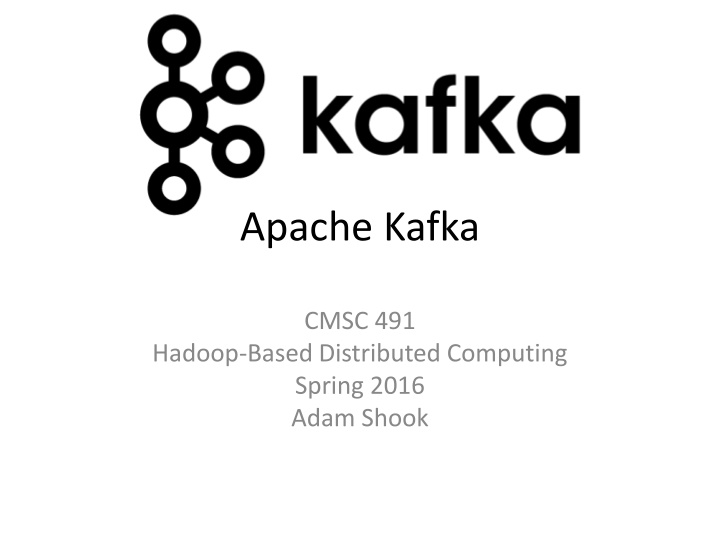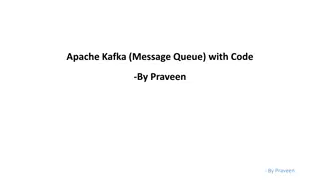
Apache Kafka: Fast, Scalable Distributed Messaging Overview
"Learn about Apache Kafka, a high-performance distributed messaging system used by top tech companies for real-time data processing. Explore Kafka's speed, efficiency, usage scenarios, and architecture."
Download Presentation

Please find below an Image/Link to download the presentation.
The content on the website is provided AS IS for your information and personal use only. It may not be sold, licensed, or shared on other websites without obtaining consent from the author. If you encounter any issues during the download, it is possible that the publisher has removed the file from their server.
You are allowed to download the files provided on this website for personal or commercial use, subject to the condition that they are used lawfully. All files are the property of their respective owners.
The content on the website is provided AS IS for your information and personal use only. It may not be sold, licensed, or shared on other websites without obtaining consent from the author.
E N D
Presentation Transcript
Apache Kafka CMSC 491 Hadoop-Based Distributed Computing Spring 2016 Adam Shook
Overview Kafka is a publish-subscribe messaging rethought as a distributed commit log Fast Scalable Durable Distributed
Kafka adoption and use cases LinkedIn: activity streams, operational metrics, data bus 400 nodes, 18k topics, 220B msg/day (peak 3.2M msg/s), May 2014 Netflix: real-time monitoring and event processing Twitter: as part of their Storm real-time data pipelines Spotify: log delivery (from 4h down to 10s), Hadoop Loggly: log collection and processing Mozilla: telemetry data Airbnb, Cisco, Gnip, InfoChimps, Ooyala, Square, Uber, 3
How fast is Kafka? Up to 2 million writes/sec on 3 cheap machines Using 3 producers on 3 different machines, 3x async replication Only 1 producer/machine because NIC already saturated Sustained throughput as stored data grows Slightly different test config than 2M writes/sec above. 4
Why is Kafka so fast? Fast writes: While Kafka persists all data to disk, essentially all writes go to the page cache of OS, i.e. RAM. Fast reads: Very efficient to transfer data from page cache to a network socket Linux: sendfile() system call Combination of the two = fast Kafka! Example (Operations): On a Kafka cluster where the consumers are mostly caught up you will see no read activity on the disks as they will be serving data entirely from cache. 5
A first look The who is who Producers write data to brokers. Consumers read data from brokers. All this is distributed. The data Data is stored in topics. Topics are split into partitions,which are replicated. 6
Topics Topic: feed name to which messages are published Example: zerg.hydra Kafka prunes head based on age or max size or key Producer A1 Kafka topic Producer A2 new Producer An Older msgs Newer msgs Producers always append to tail (think: append to a file) Broker(s) 8
Topics Consumers use an offset pointer to track/control their read progress (and decide the pace of consumption) Consumer group C1 Consumer group C2 Producer A1 Producer A2 new Producer An Older msgs Newer msgs Producers always append to tail (think: append to a file) Broker(s) 9
Partitions A topic consists of partitions. Partition: ordered +immutable sequence of messages that is continually appended to 10
Partitions #partitions of a topic is configurable #partitions determines max consumer (group) parallelism cf. parallelism of Storm s KafkaSpout via builder.setSpout(,,N) Consumer group A, with 2 consumers, reads from a 4-partition topic Consumer group B, with 4 consumers, reads from the same topic 11
Partition offsets Offset: messages in the partitions are each assigned a unique (per partition) and sequential id called the offset Consumers track their pointers via (offset, partition, topic) tuples Consumer group C1 12
Replicas of a partition Replicas: backups of a partition They exist solely to prevent data loss. Replicas are never read from, never written to. They do NOT help to increase producer or consumer parallelism! Kafka tolerates (numReplicas - 1) dead brokers before losing data LinkedIn: numReplicas == 2 1 broker can die 13
Kafka Quickstart Steps for downloading Kafka, starting a server, and creating a console-based consumer/producer Requires ZooKeeper to be installed and running https://kafka.apache.org/documentation.html #quickstart https://github.com/adamjshook/hadoop- demos/tree/master/kafka







